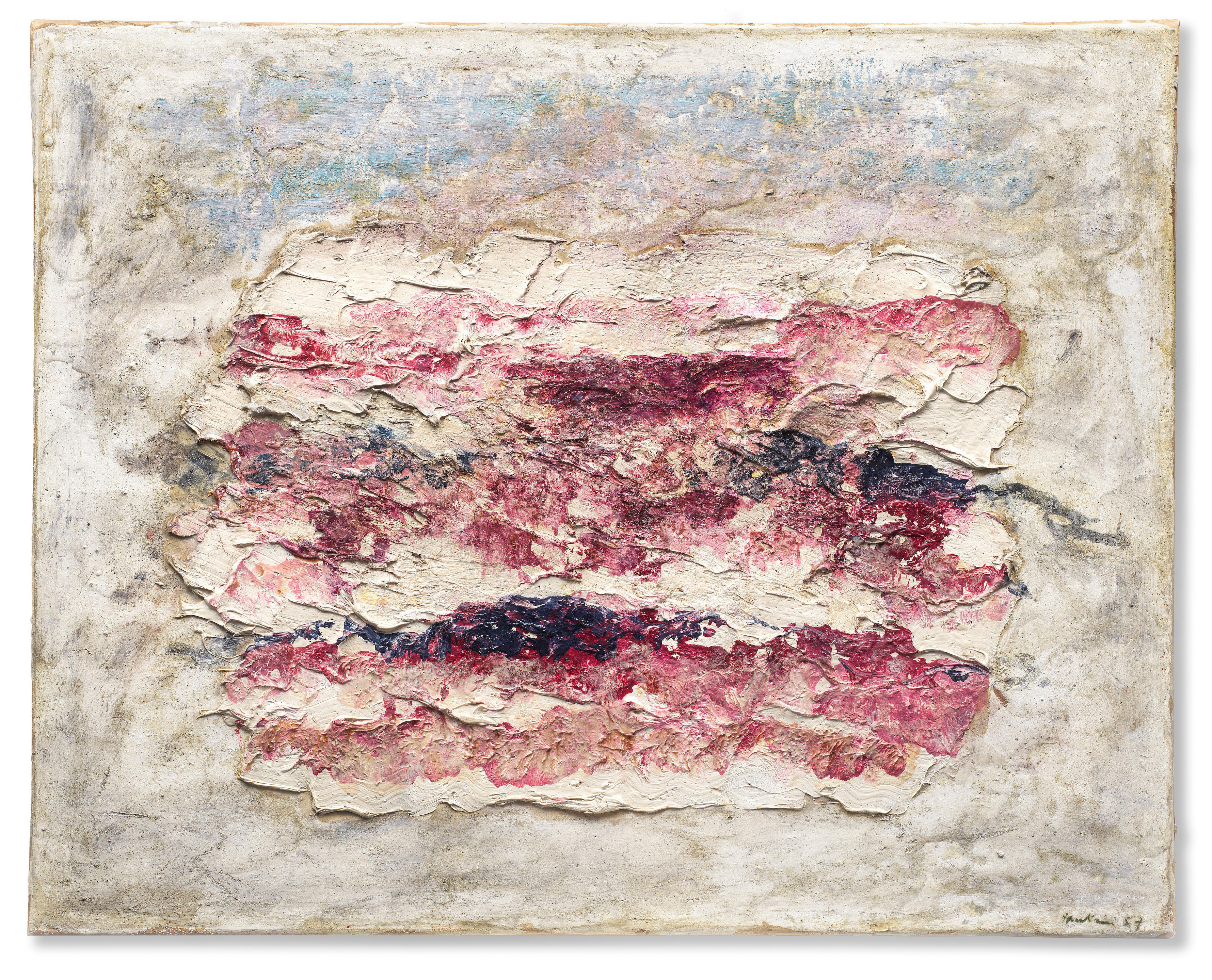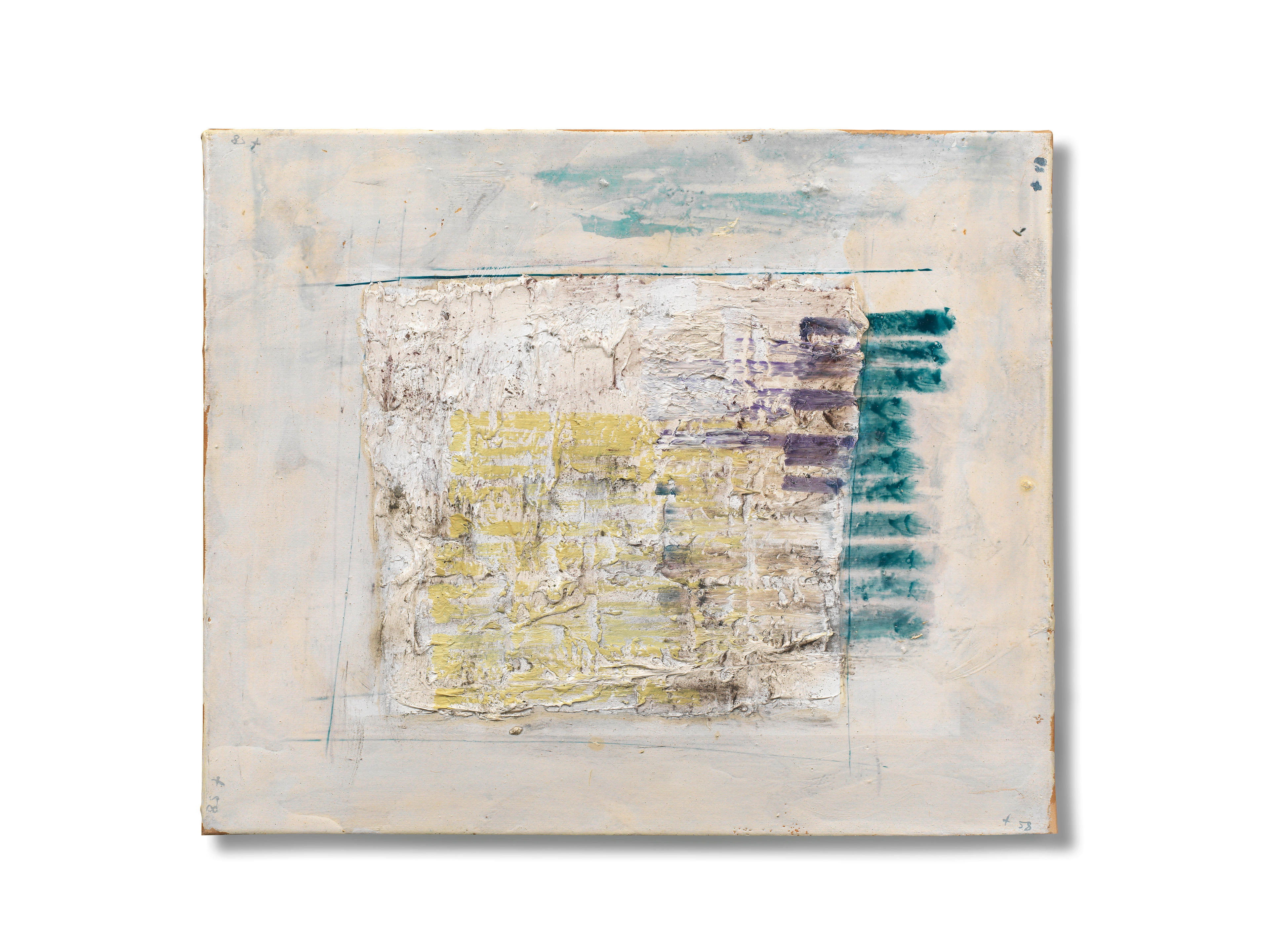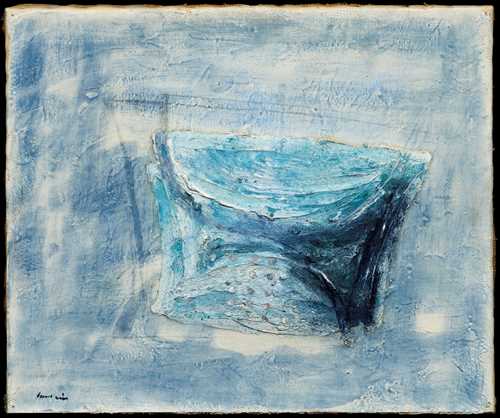Property From a Private European Collector Jean Fautrier Ba Be Bi Bo Bu 1958 oil and pigment on paper laid on canvas 60 x 73 cm (23 5/8 x 28 3/4 in.) Signed and dated ‘Fautrier 58’ lower right.
Provenance Coll. Ermanno Grube, Milan Galerie Bonnier, Geneva Acquired from the above by the present owner in the early 1980s Literature P. Bucarelli, Jean Fautrier Milan, 1960, no. 415 p. 362-363 (illustrated) Jean Fautrier Retrospective, exh. cat., Musée d’Art Moderne de la Ville de Paris, Paris, 1964, n.p. (illustrated) This work will be included in the forthcoming Jean Fautrier Catalogue Raisonné being prepared by Marie-José Lefort, Geneva. Catalogue Essay Completed shortly after some paintings in homage to the victims of the Hungarian Revolution, Ba Be Bi Bo Bu executed in 1958 marks the artist’s lively return to the realm of abstraction after the sombre Head of Partisan series. In direct contrast to the hauntingly beautiful yet tormented and tragic portraits of victims, Jean Fautrier’s return to the light coloured abstraction of this work demonstrates the joyful free-style technique of mixing media, such as paper paste blended with pigment that he invented and developed during this period. Ba Be Bi Bo Bu, is a testament of the mythical fringe of reality in which the artist and his materials lived. Profoundly original, this artwork - and the techniques employed to paint it - testify to the violence and passion that surround the scandalous modernity of his oeuvre. Assuming a radical and unprecedented approach to painting, layers of paper paste are laid atop the canvas upon which hues of grey, blue, and forest green are highlighted with strokes of violet and yellow. With a hallucinatory expressiveness, the colours and lines radiate with an interior luminosity only attained by the masterful technique of the artist. ‘This is what you want to know,’ the artist explained, ‘the canvas is now merely a support for the painter. The thick paper is covered with sometimes thick layers of plaster - the picture is painted on this moist plaster - this plaster makes the paint adhere to the paper perfectly - it has the virtue of fixing the colours in powder, crushed pastels, gouache, ink, and also oil paint - it is above all thanks to these coats of plaster that the mixture can be produced so well and the quality of the matter is achieved.’ (Letters to Jean Paulhan, cited in Jean Fautrier 1898-1964, exh. cat., Harvard University Art Museums 2002, pp. 43-44) The pigments suspended in oil animate the work extensively as the brushwork pulsates beneath the compelling composition. In this piece, Fautrier created an orchestra of colours and forms that harmonize in a blissful exchange with the materials just as a jazz musician might improvise on a classical version of a melody. It is possible that this is perhaps where the title of this work derives for ba be bi bo bu are often used non-lexical vocables in music, specifically in jazz records of the time. In fact, Fautrier made other abstract paintings during this period whose titles are directly taken from jazz songs such as I’m Falling in Love from 1957. This interpretation of the title adds to the joyous and lively appearance of the work. Fautrier was one of the most important practitioners of Tachisme, the French style of abstract painting equivalent to Abstract Expressionism. Other major figures of the movement include Wols, Jean Dubuffet and Georges Mathieu The culmination of this movement happened between the 1940s and 1950s. It is part of a larger post-war movement known as Art Informel. The term Art Informel refers to a lack or absence of form itself. In specific, Art Informel celebrates a lack of a predetermined structure rather than a relaxed or loose approach to making art. The manner with which Fautrier broke with traditional forms and methodologies was unmatched by his contemporaries in France in part due to his existentialist approach to life and his total dedication to art. Similarly to American painters, such as Jackson Pollock Robert Motherwell and Mark Tobey Fautrier used paint to create a relief-like built up surface where the expressiveness of the brushwork and paint ar
Property From a Private European Collector Jean Fautrier Ba Be Bi Bo Bu 1958 oil and pigment on paper laid on canvas 60 x 73 cm (23 5/8 x 28 3/4 in.) Signed and dated ‘Fautrier 58’ lower right.
Provenance Coll. Ermanno Grube, Milan Galerie Bonnier, Geneva Acquired from the above by the present owner in the early 1980s Literature P. Bucarelli, Jean Fautrier Milan, 1960, no. 415 p. 362-363 (illustrated) Jean Fautrier Retrospective, exh. cat., Musée d’Art Moderne de la Ville de Paris, Paris, 1964, n.p. (illustrated) This work will be included in the forthcoming Jean Fautrier Catalogue Raisonné being prepared by Marie-José Lefort, Geneva. Catalogue Essay Completed shortly after some paintings in homage to the victims of the Hungarian Revolution, Ba Be Bi Bo Bu executed in 1958 marks the artist’s lively return to the realm of abstraction after the sombre Head of Partisan series. In direct contrast to the hauntingly beautiful yet tormented and tragic portraits of victims, Jean Fautrier’s return to the light coloured abstraction of this work demonstrates the joyful free-style technique of mixing media, such as paper paste blended with pigment that he invented and developed during this period. Ba Be Bi Bo Bu, is a testament of the mythical fringe of reality in which the artist and his materials lived. Profoundly original, this artwork - and the techniques employed to paint it - testify to the violence and passion that surround the scandalous modernity of his oeuvre. Assuming a radical and unprecedented approach to painting, layers of paper paste are laid atop the canvas upon which hues of grey, blue, and forest green are highlighted with strokes of violet and yellow. With a hallucinatory expressiveness, the colours and lines radiate with an interior luminosity only attained by the masterful technique of the artist. ‘This is what you want to know,’ the artist explained, ‘the canvas is now merely a support for the painter. The thick paper is covered with sometimes thick layers of plaster - the picture is painted on this moist plaster - this plaster makes the paint adhere to the paper perfectly - it has the virtue of fixing the colours in powder, crushed pastels, gouache, ink, and also oil paint - it is above all thanks to these coats of plaster that the mixture can be produced so well and the quality of the matter is achieved.’ (Letters to Jean Paulhan, cited in Jean Fautrier 1898-1964, exh. cat., Harvard University Art Museums 2002, pp. 43-44) The pigments suspended in oil animate the work extensively as the brushwork pulsates beneath the compelling composition. In this piece, Fautrier created an orchestra of colours and forms that harmonize in a blissful exchange with the materials just as a jazz musician might improvise on a classical version of a melody. It is possible that this is perhaps where the title of this work derives for ba be bi bo bu are often used non-lexical vocables in music, specifically in jazz records of the time. In fact, Fautrier made other abstract paintings during this period whose titles are directly taken from jazz songs such as I’m Falling in Love from 1957. This interpretation of the title adds to the joyous and lively appearance of the work. Fautrier was one of the most important practitioners of Tachisme, the French style of abstract painting equivalent to Abstract Expressionism. Other major figures of the movement include Wols, Jean Dubuffet and Georges Mathieu The culmination of this movement happened between the 1940s and 1950s. It is part of a larger post-war movement known as Art Informel. The term Art Informel refers to a lack or absence of form itself. In specific, Art Informel celebrates a lack of a predetermined structure rather than a relaxed or loose approach to making art. The manner with which Fautrier broke with traditional forms and methodologies was unmatched by his contemporaries in France in part due to his existentialist approach to life and his total dedication to art. Similarly to American painters, such as Jackson Pollock Robert Motherwell and Mark Tobey Fautrier used paint to create a relief-like built up surface where the expressiveness of the brushwork and paint ar






.jpg)








Testen Sie LotSearch und seine Premium-Features 7 Tage - ohne Kosten!
Lassen Sie sich automatisch über neue Objekte in kommenden Auktionen benachrichtigen.
Suchauftrag anlegen